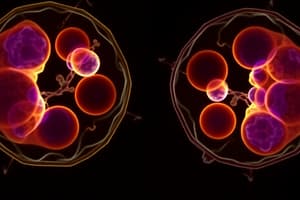Podcast
Questions and Answers
What occurs during Interphase?
What occurs during Interphase?
- DNA replicates (correct)
- Cell grows and carries out normal cell processes (correct)
- Chromosomes unwind into chromatin
- Nuclear membrane disintegrates
What happens during Prophase?
What happens during Prophase?
Nuclear membrane disintegrates, nucleolus disappears, chromatin coils into chromosomes, spindle fibers begin to form between the poles.
Describe the Metaphase stage of cell division.
Describe the Metaphase stage of cell division.
Spindle fibers attach to paired sister chromatids and chromosomes move to the equator.
What occurs during Anaphase?
What occurs during Anaphase?
What are the key events that occur during Telophase?
What are the key events that occur during Telophase?
What is Cytokinesis?
What is Cytokinesis?
Flashcards are hidden until you start studying
Study Notes
Interphase
- The cell undergoes growth and performs normal cellular functions.
- DNA replication occurs, ensuring each new cell has an identical set of DNA.
- DNA exists in the form of chromatin, dispersed throughout the nucleus.
- Centrioles containing a centromere are located outside the nuclear membrane.
Prophase
- The nuclear membrane disintegrates, allowing access to the genetic material.
- The nucleolus disappears, marking the transition to mitosis.
- Chromatin condenses into distinct chromosomes, making them visible under a microscope.
- Spindle fibers begin to form, originating from the poles of the cell.
Metaphase
- Spindle fibers attach to the paired sister chromatids, securing them for separation.
- Chromosomes align at the cell's equator, organizing for division.
Anaphase
- Sister chromatids separate as the centromere splits, transitioning to individual chromosomes.
- Spindle fibers shorten, pulling chromatids toward opposite poles of the cell.
Telophase
- Chromosomes unwind back into chromatin, preparing for the next interphase.
- The nuclear membrane reforms around each set of chromosomes.
- The nucleolus reappears, signaling the end of nuclear division.
- Centrioles and spindle fibers disappear, concluding mitotic processes.
Cytokinesis
- This process immediately follows mitosis, completing cell division.
- In animal cells, a cleavage furrow forms at the cell's equator, pinching inwards until the cell splits into two separate cells.
Studying That Suits You
Use AI to generate personalized quizzes and flashcards to suit your learning preferences.



